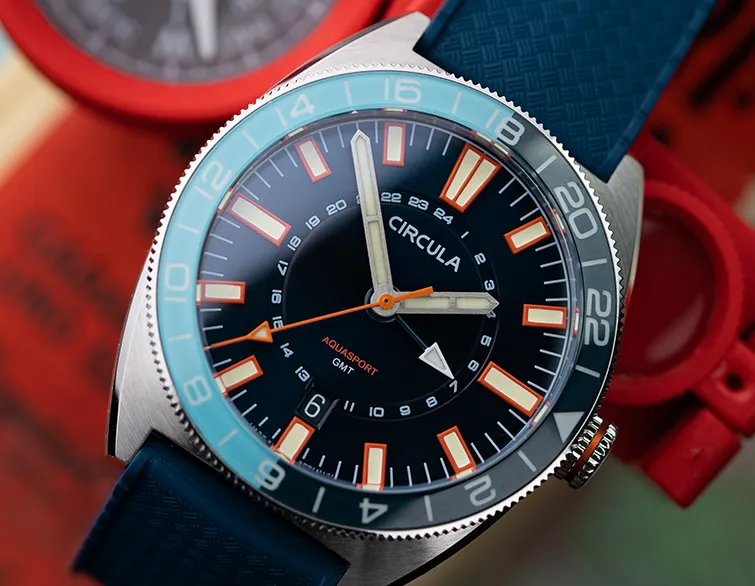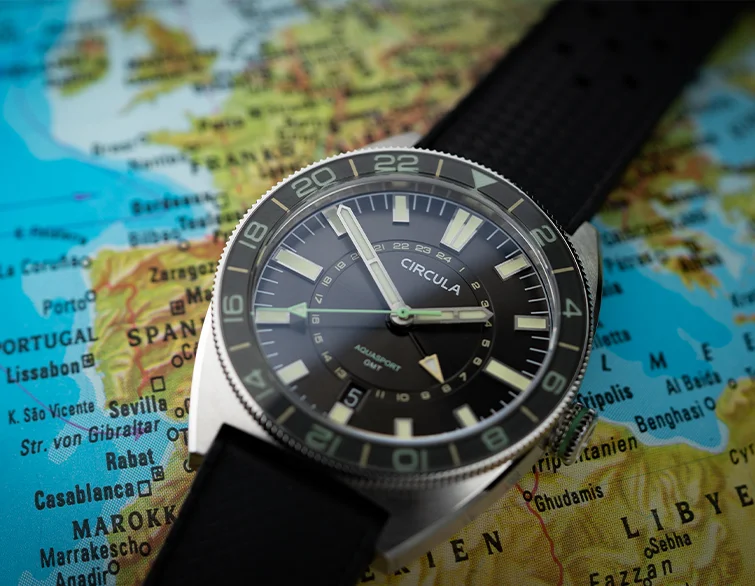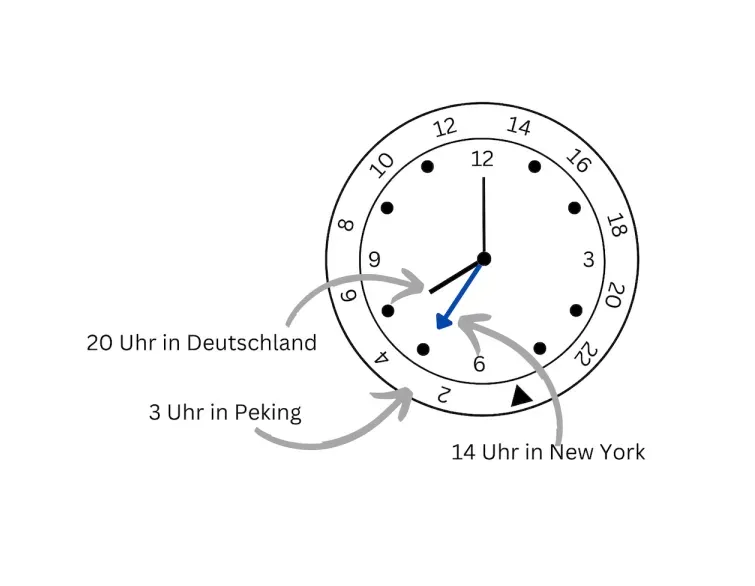GMT-Uhren und GMT-Funktion
verständlich erklärt
Die GMT-Zeit
Bedeutung und Geschichte
Die GMT-Funktion
GMT-Zeiger
Der GMT-Zeiger ist ein zusätzlicher Stundenzeiger, der sich optisch durch seine Größe und seine meist markante Farbe von den restlichen Zeigern abhebt und sich je nach Art der GMT-Uhr abhängig oder unabhängig bewegen lässt. Anders als der normale Stundenzeiger benötigt der GMT-Zeiger 24 Stunden, um das Ziffernblatt der Uhr einmal zu umrunden.
GMT-Lünette
Neben dem GMT-Zeiger spielt auch die GMT-Lünette bei Uhren mit GMT-Funktion eine wichtige Rolle. Mithilfe der GMT-Lünette lässt sich nämlich die zweite bzw. dritte Zeitzone einstellen. Die GMT-Lünette zeigt ebenso wie der GMT-Zeiger 24-Stunden an und ist üblicherweise zweifarbig, um Tag und Nacht unterscheiden zu können. Im Gegensatz zur Taucheruhren-Lünette lässt sich die GMT-Lünette normalerweise in beide Richtungen drehen.
GMT-Uhr richtig einstellen
Um eine GMT-Uhr richtig einzustellen, muss man zunächst wissen, was für eine GMT-Uhr man eigentlich hat. Es gibt zwei verschiedene Uhrentypen mit GMT-Funktion: GMT-Uhren der ersten Generation, bei denen sich Stunden- und GMT-Zeiger nur gleichzeitig bewegen lassen und GMT-Uhren der zweiten Generation, bei denen sich der Stunden- und GMT-Zeiger unabhängig voneinander bewegen lassen. GMT-Uhren der zweiten Generation können nochmal in Office-GMT bzw. Caller-GMT und True-GMT bzw. Traveller-GMT unterteilt werden.

GMT-Uhren der ersten Generation einstellen
Bei den GMT-Uhren der ersten Generation lassen sich GMT-Zeiger und Stundenzeiger nicht unabhängig voneinander bewegen, da sie miteinander verbunden sind. Das bedeutet, dass immer, wenn man den Stundenzeiger bewegt, sich gleichzeitig auch der GMT-Zeiger mitbewegt. Wichtig für das Verständnis ist hierbei, dass sich der Stundenzeiger im 12-Stunden-Intervall bewegt und der GMT-Zeiger, wie bereits geschrieben, im 24-Stunden-Intervall.
Möchte man sich bei einer GMT-Uhr der ersten Generation nun mittels der GMT-Funktion eine zweite Zeitzone anzeigen lassen, dann stellt man den Stundenzeiger zunächst so ein, dass er die Ortszeit anzeigt. Für die zweite Zeitzone wird dann die 24-Stunden GMT-Lünette so am mitgelaufenen GMT-Zeiger ausgerichtet, dass der Zeiger auf die entsprechende Zahl auf der Lünette zeigt, die der Uhrzeit der gewünschten Zeitzone entspricht.
Das bedeutet zum Beispiel, dass wenn es in Deutschland 20 Uhr (Winterzeit) ist, dann ist es in New York 14 Uhr. Der GMT-Zeiger steht bei den GMT-Uhren der ersten Generation auf der 10-Uhr-Position. Um die New Yorker Zeit anzuzeigen, wird nun die Lünette so lange gedreht, bis der GMT-Zeiger auf die 14-Uhr-Markierung der Lünette zeigt.
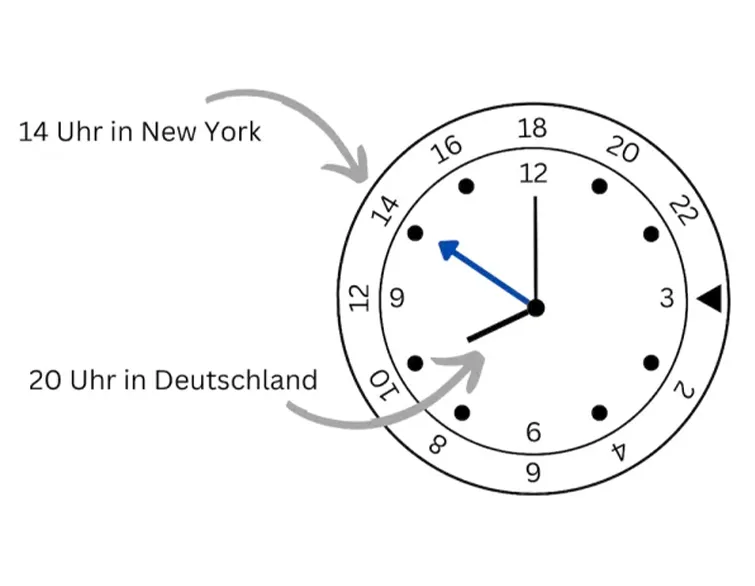
GMT-Uhren der zweiten Generation einstellen
Bei den GMT-Uhren der zweiten Generation lassen sich im Gegensatz zur ersten Generation der GMT-Zeiger und der Stundenzeiger unabhängig voneinander bewegen.
Hier gibt es, wie weiter oben bereits erwähnt, zwei verschiedene Typen:
- Office-GMT bzw. Caller-GMT, bei welcher mit dem GMT-Zeiger üblicherweise eine fremde Zeitzone angezeigt wird und
- True-GMT bzw. Traveller-GMT, bei welcher mit dem GMT-Zeiger üblicherweise die Heimatzeit angezeigt wird.
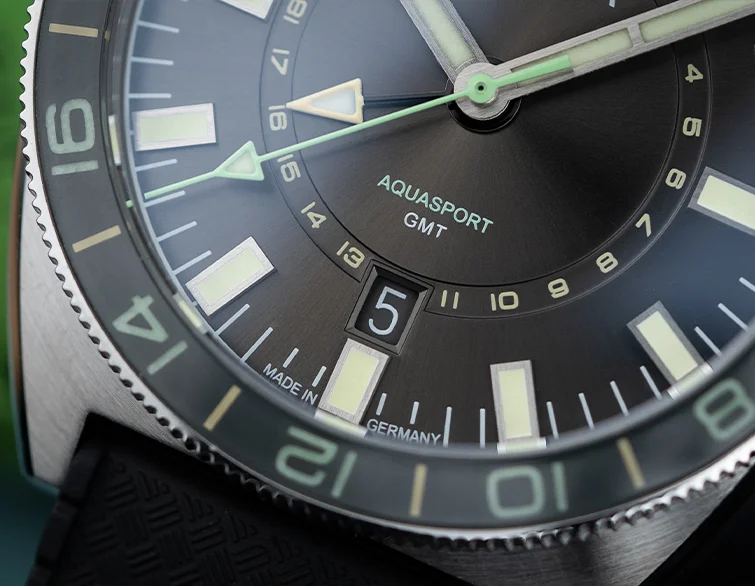
Caller-GMT bzw. Office-GMT einstellen
Bei der Office-GMT lässt sich durch Drehen der Krone in der zweiten Position der GMT-Zeiger vorwärts einstellen und – sofern die Uhr über eine Datumsanzeige verfügt – das Datum mit dem Drehen der Krone in die andere Richtung ändern. Die lokale Uhrzeit wird dadurch nicht geändert, was sehr praktisch ist.In der dritten Position der Krone bewegen sich alle Zeiger gemeinsam. Um eine zweite Zeitzone einzustellen, muss also lediglich der GMT-Zeiger an der Lünette ausgerichtet werden.
Will man zusätzlich eine dritte Zeitzone einstellen, dann richtet man, genau wie bei den GMT-Uhren der ersten Generation, zusätzlich die GMT-Lünette am GMT-Zeiger aus. In diesem Fall muss man sich dann für die zweite Zeitzone an den Stundenangaben auf dem Ziffernblatt orientieren und diese Zahl mit zwei multiplizieren, da der GMT-Zeiger für eine Umrundung des Ziffernblatts 24 Stunden benötigt und nicht nur 12 wie der normale Stundenzeiger. Manche GMT-Uhren, wie z.B. die Circula AquaSport GMT erleichtern das Ablesen einer dritten Zeitzone durch eine zusätzliche 24-Stunden-Anzeige auf dem Zifferblatt.
True-GMT bzw. Traveller-GMT einstellen
Bei der Traveller-GMT lässt sich durch Drehen der Krone in der zweiten Position der Stundenzeiger für die lokale Zeit in beide Richtungen einstellen, während der GMT-Zeiger sich nicht bewegt.
In der dritten Position der Krone bewegen sich alle Zeiger zusammen. Um nach der Ankunft in einer anderen Zeitzone die neue Ortszeit einstellen, muss man also lediglich den Stundenzeiger für die lokale Zeit stellen, während der GMT-Zeiger, der die Heimatzeit anzeigt, sich nicht mitbewegt. Bei einer zusätzlichen dritten Zeitzone richtet man wie bei den beiden anderen GMT-Uhrentypen die GMT-Lünette entsprechend am GMT-Zeiger aus.
Ist man also um 14 Uhr in New York gelandet, dann stellt man mit der zweiten Kronenposition den Stundenzeiger auf 14 Uhr, während der GMT-Zeiger bei 20 Uhr (Deutschland) stehen bleibt. Um zusätzlich noch die Zeit in Peking anzeigen zu lassen, kann man auch bei diesem GMT-Uhrentyp die Lünette so ausrichten, dass der GMT-Zeiger auf 3 Uhr zeigt.
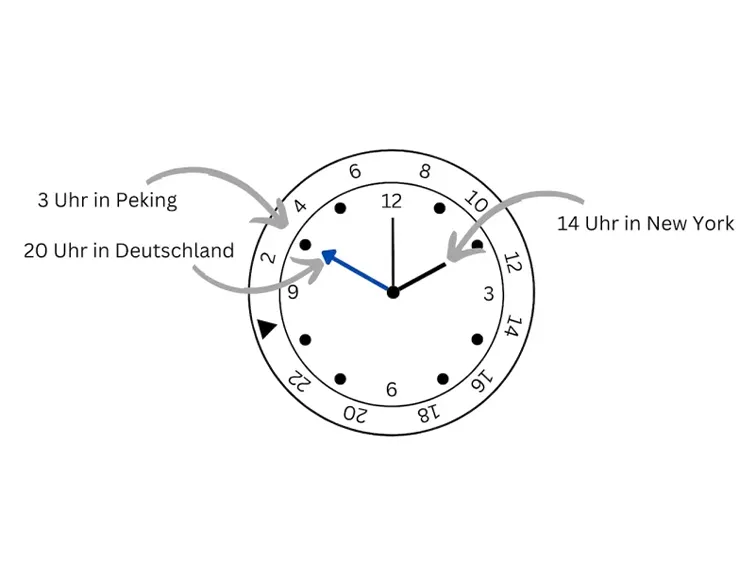
Office-GMT vs. True-GMT
Wie die Namen der beiden Typen von GMT-Uhren und auch die Beschreibungen schon vermuten lassen, ist die Office-GMT besser geeignet, wenn man mit dem GMT-Zeiger die Uhrzeit einer anderen Zeitzone anzeigen lässt und die Traveller-GMT ist besser geeignet, wenn man auf Reisen ist und mit dem GMT-Zeiger die Heimatzeit im Blick behalten möchte.
Die Gründe dafür sind simpel: Hat man eine Traveller-GMT, obwohl man sich eigentlich hauptsächlich in der Heimatzeitzone aufhält, dann bewegt sich bei jedem Stellen der Uhrzeit der GMT-Zeiger mit (dritte Position der Krone). Das heißt, dass man die Uhr zunächst so stellen muss, dass der GMT-Zeiger an der gewünschten Position steht und erst anschließend kann man den Stundenzeiger entsprechend einstellen. Genau andersherum verhält es sich mit der Office-GMT auf Reisen: Da sich hier nur der GMT-Zeiger separat bewegen lässt, muss man auf Reisen zunächst alle Zeiger verstellen (dritte Position der Krone), um die lokale Uhrzeit einzustellen und anschließend muss der GMT-Zeiger wieder auf die Heimatzeit gestellt werden (zweite Position der Krone).
Auf Reisen ist die Traveller-GMT deshalb praktischer, da man mit der 2. Kronenposition einfach den Stundenzeiger verstellen kann, um die lokale Uhrzeit einzustellen während der GMT-Zeiger für die Heimatzeit unverändert bleibt. Im Büro ist es genau umgekehrt. Hier ist die Office-GMT besser geeignet, da sich mit der zweiten Kronenposition der GMT-Zeiger separat stellen lässt und sich dabei die lokale Uhrzeit nicht ändert.
Circula AquaSport
mit GMT-Funktion
Die Circula AquaSport GMT ist eine klassische Office-GMT. Sie ist die perfekte Wahl für alle, die sich hauptsächlich in der eigenen Zeitzone aufhalten und Kontakte in anderen Zeitzonen pflegen. Zusätzlich zur Lünette hat die GMT-Uhr von Circula auf dem Ziffernblatt eine zusätzliche 24-Stunden-Skala, sodass das Ablesen der verschiedenen Uhrzeiten auch bei einer dritten Zeitzone auf einen Blick möglich ist! Statt des Sellita SW200-1 Uhrwerks, dass bei der Taucheruhr AquaSport II verbaut ist, kommt in der Circula AquaSport GMT das Sellita SW330-2-Uhrwerk in Top-Ausführung zum Einsatz. Dieses spezielle GMT-Kaliber der Spitzenklasse basiert auf dem ETA 2892-A2 und ermöglicht eine zweite Zeitzonenanzeige mittels eines zentral angeordneten GMT-Zeigers.
Anders als die einseitig drehbare Lünette der AquaSport II-Taucheruhr lässt sich die Saphirglas-Lünette der AquaSport GMT in beide Richtungen drehen. Die Lünette verfügt über eine 48er-Rasterung und die Indexe sind mit Swiss Super-LumiNova® BGW9 gefüllt.
Die sonstigen Spezifikationen der Circula AquaSport GMT entsprechen der Circula AquaSport II:
- Kratzfestes, leicht gewölbtes und innen doppelt entspiegeltes Saphirglas
- Zeiger und Indexe gefüllt mit Swiss Super-LumiNova® C3 X1
- 200 Meter wasserdicht, verschraubte Krone (leuchtend)
- 40 mm Durchmesser, 46 mm Horn zu Horn und 12,6 mm Höhe.
